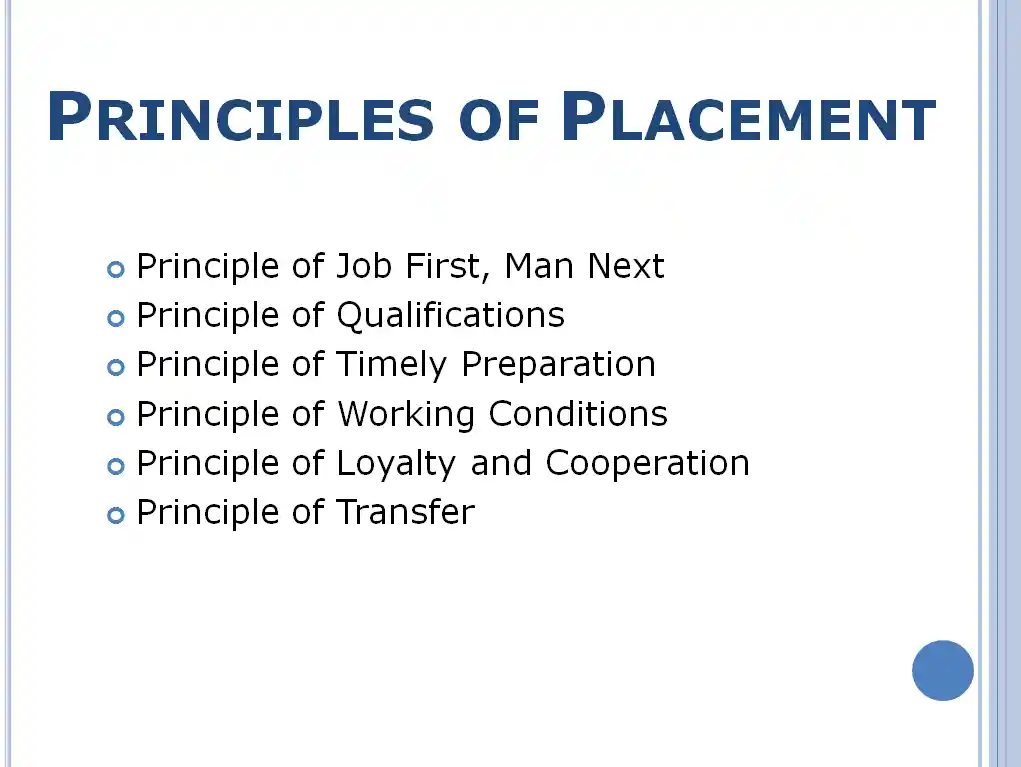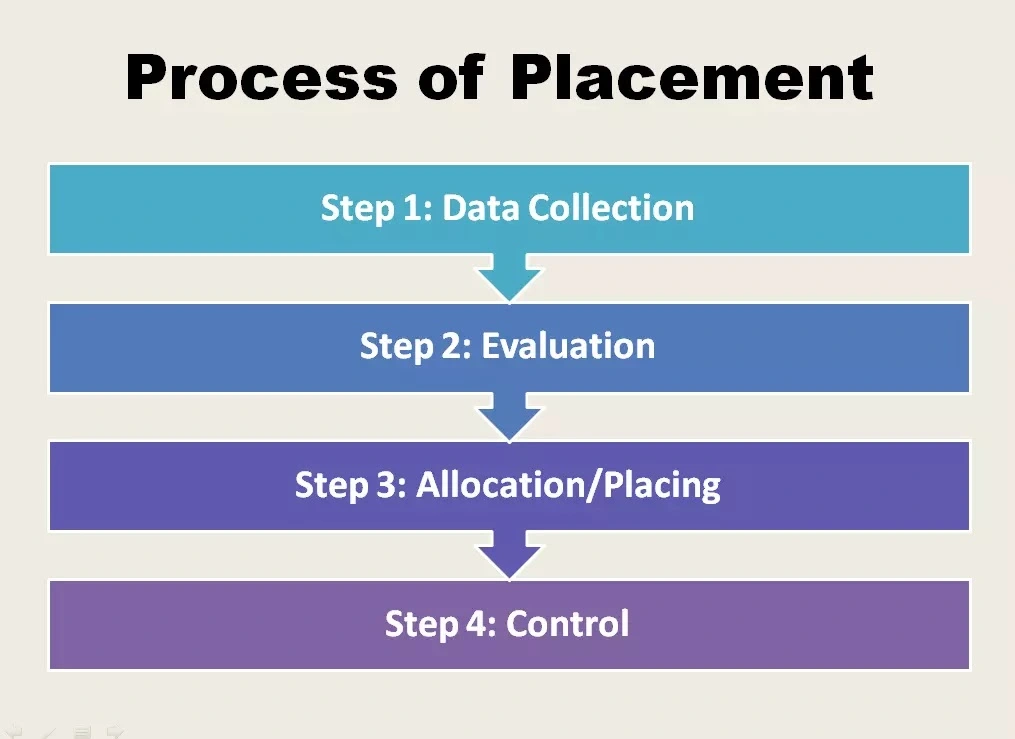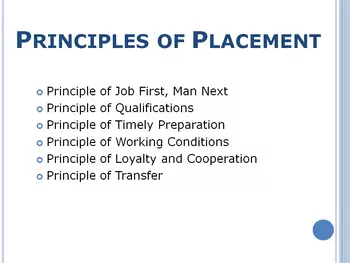Table of Contents:
- Meaning of Placement in hrm
- Definition of Placement in hrm
- Principles of Placement in hrm
- Process of Placement in HRM
- Importance of Placement in HRM
- Problems Associated with Placement in hrm
Meaning of Placement in hrm
Placement in HRM is the process of assigning employees to specific positions, roles, or jobs within an organization. For effective placement in HRM, an HR manager should understand the company’s goals and values. They should ensure that individuals’ skills, qualifications, and abilities match what a particular job requires.
Once an employee is hired, they should be assigned to the appropriate job. Placement refers to the assignment of people to jobs. Depending on the situation, it involves assigning or reassigning employees to new or different roles. Thus, placement places the right person in the right job, aiming to align hired candidates with roles matching their skills.
Definition of Placement in hrm
According to Dale Yoder, “The assignment of a particular job to a newly appointed employee is the placement”.
According to Pigors and Myers, “Placement is the determination of the job to which an accepted candidate is to be assigned, and his assignment to that job. It is a matching of what the supervisor has reason to think he can do with the job demands. It is matching of what he imposes in strain, working conditions, and what he offers in the form of payroll, companionship with others, promotional possibilities, etc.”
Principles of Placement in hrm
The following principles are followed when placing employees in their respective roles:

1) Principle of Job First, Man Next
The principle of “Job First, Man Next” means an individual should be placed by job requirements instead of modifying the job according to the individual’s needs and credentials.
2) Principle of Qualifications
Employers should ensure that employees are placed and given roles that match their qualifications, experience and skills to contribute effectively to the organization. Avoid placing employees in roles that are overly high or very low in the organizational structure.
3) Principle of Timely Preparation
All the arrangements that are required for placement should be done before the joining date of the newly hired employees.
4) Principle of Working Conditions
The employees should be made aware of all the relevant information regarding the current working conditions of the company. The employees should be made aware of all the information regarding working conditions existing in the company. He should also be provided information about punishments if he makes any mistakes.
5) Principle of Loyalty and Cooperation
Employees should be made to feel a sense of commitment and cooperation in their new job so that they can understand their tasks and responsibilities nicely towards the job and the organization.
6) Principle of Transfer
Initially, placement can be temporary as changes may occur once the training is completed. Transfer of the employee to another job may occur where he can perform as expected.
Process of Placement in HRM
There are four steps in the procedure of placement of employees that must be followed systematically to make sure that training given to employees becomes successful, these four steps are given as follows:

1 Step: Data Collection: The first step in the employee placement process involves gathering employee data to identify their qualifications, skills, and abilities.
2 Step: Evaluation: Once the initial step of gathering employee data is complete, the next step is to evaluate the abilities of employees to analyze and determine the most suitable job that best suits them.
3 Step: Allocation/Placing: In this step, the company places the employee on the job that is best suitable for him.
4 Step: Control: The final step is the procedure of control. This step involves evaluating and monitoring the employee’s performance in their particular job.
Importance of Placement in HRM
The importance of good placement is as follows
1) Raises Employee Morale: Proper placement makes it easier for the employee to adjust himself to the work and helps him to give a standard performance. This helps to raise the morale of the employee.
2) Keeps Employees Motivated: Employees are motivated if they are properly placed by matching their skills and job requirements. If they are motivated they produce better output.
3) Reduces Labour Turnover and Absenteeism: If employees are properly placed in their jobs then absenteeism and employee turnover are reduced. This results in the effective utilisation of machines, equipment and materials.
4) Increases Employee Efficiency: Proper placement helps to improve an employee’s efficiency as he can produce better results, communicate with people effortlessly, feel motivated, become punctual, and avoid committing errors.
5) Keeps Employees Satisfied: Placement helps to keep employees satisfied. If an employee is appropriately placed in his job he works with zeal and his work performance is high.
Problems Associated with Placement in hrm
Placement is not an easy task. It needs to match employee skills with job requirements. Though the HR manager tries to make it justifiable and effective, a few problems arise.
Some of the problems are as follows:
1) Employee Expectations
The main problem with placement is employee expectations. Employees generally expect high salaries, difficult tasks, and autonomy and if their job does not fulfil their expectations, they feel that they are in a job that is not appropriate for them.
2) Manager’s Expectations
The HR manager sometimes may have expectations more than the employee’s capabilities or skills. This can result in a mismatch between the skills of the employees and the tasks assigned to them.
3) Change in Technology
Technology has changed job description and job specification. Due to these changes, the discrepancies result in a mismatch between the job and the employee occurs.
4) Changes in Organisational Structure
Organizational structure and jobs are influenced by business grand strategies such as mergers, acquisitions, downsizing, de-layering, etc. These changes result in a mismatch between the employee and his job.
5) Social and Psychological Factors
The mismatch is sometimes also due to social and psychological factors involved in teamwork or group formation.
6) Nature of Job
Another problem with placement is that the focus is on the individual rather than the job. Many times, the employees may struggle to perform well without the support and collaboration of their colleagues. The kind of job will determine whether the employee works with autonomy or is dependent on others.
In this context, there are three types of jobs which are given as follows:
i) Independent: In some cases, jobs are independent, such as those in the postal service or field sales. In such conditions, the activities of one employee do not depend upon the activities of other employees. The issue of placement in these roles is straightforward, as solutions for it have been developed.
ii) Sequential: In this category, a worker depends on the other worker to do his job. Assembly lines are the best example of sequential jobs.
iii) Pooled: High interdependence is present among the activities when the jobs are pooled. The result is the joint effort of all the workers. Teamwork matters a lot in such jobs. Examples of pooled jobs are project teams, temporary task forces assembly teams, etc.
FAQs
1. What is Placement?
After an employee has been hired and oriented, they must be placed in the right job. Placement can be understood as the allocation of jobs to people. Assigning a new employee to a job may seem straightforward, but more complex. The challenge with placement is that we often focus on the individual rather than the job. Frequently, individuals do not work independently but as part of a team. Jobs in this context may be classified into three categories: independent, sequential, and pooled.
You May Also Like:-
Methods of Management Development
Workers Participation in Management
Features of Management Development
Human Resource Development Mechanisms
Process of Human Resource Planning
360 Degree Performance Appraisal
Limitations of Human Resource Planning
Difference between Personnel Management and HRM
